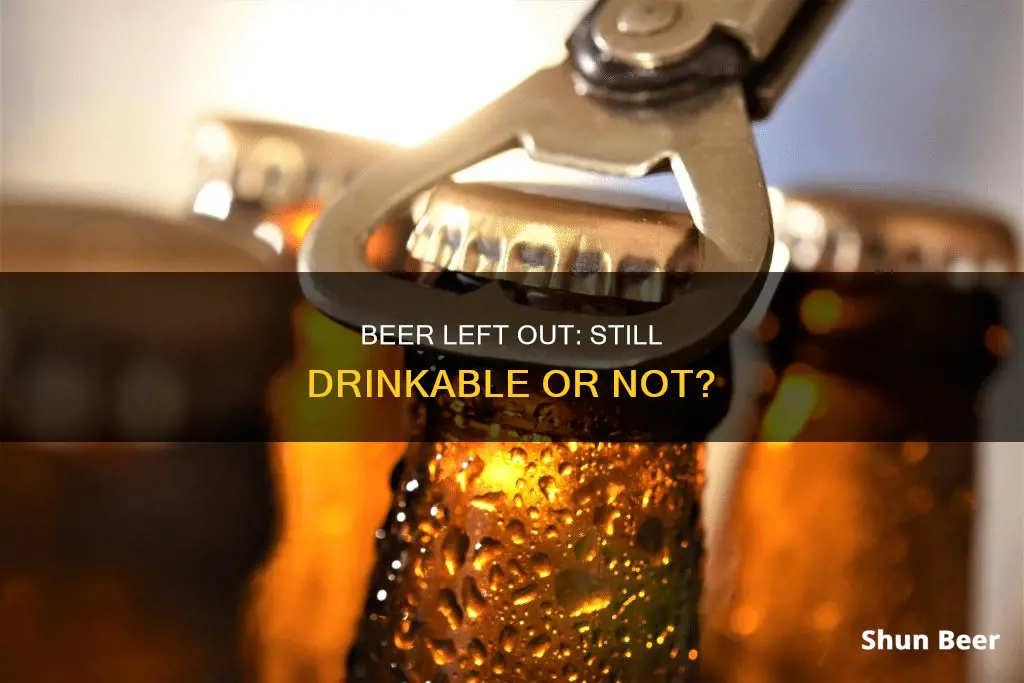
Drinking a beer that's been left open is something most drinkers have done, and it's generally not a big deal. But what happens if you leave it out for too long? Is it still safe to drink?
The short answer is yes, you can drink beer that's been left open, but it's best to finish it within a day or two for the best flavour. Beer that's been left open begins to oxidize, resulting in changes to its colour, appearance, aroma, and taste. It will also start to go flat as it loses carbonation.
While beer does expire, it doesn't usually become unsafe to consume. However, it's important to watch out for signs of spoilage, such as an unpleasant taste, cloudy appearance, or bad odour, as these could indicate bacterial growth.
To extend the shelf life of an opened beer, it's best to keep it chilled, as this slows down the oxidation process. You can also use airtight containers or add a few drops of sterile beer salts to inhibit bacterial growth.
| Characteristics | Values |
|---|---|
| How long can an open beer be left out? | An open beer should be consumed within 1-2 days. |
| Is it safe to drink a beer left open overnight? | Drinking a beer left open overnight won't cause health issues but it may taste flat and lose its flavour. |
| What happens if a left-open beer is refrigerated? | Refrigerating a left-open beer can slow oxidation and preserve its freshness for a little longer but the overall quality and taste may still be affected. |
| Are there any signs of spoilage in an open beer? | Yes, an open beer that has gone bad will likely be darker or cloudy, with particles or sediment floating in it. It may also have off-smells like vinegar or rotten eggs and unusual flavours such as sourness or bitterness. |
| How to extend the shelf life of a beer? | Store beer in a cool, dry place with temperatures between 35 and 55 degrees Fahrenheit (2 to 13 degrees Celsius). Keep it away from light and store it upright in a refrigerator if possible. |
What You'll Learn

Beer left out for a day or two is safe to drink
Beer is a delicate beverage, and its shelf life is influenced by several factors, including whether it's sealed or open, the storage temperature, and exposure to light and oxygen. While a bottled beer stored at room temperature can last up to six months, an open beer is only fresh for 1-2 days.
If you leave a beer out for a day or two, it is still safe to drink, but there will be noticeable changes in its quality. The flavour and aroma will not be as pleasant, and it may lose its carbonation, becoming "flat." This is because, when left out, beer undergoes oxidation, which affects its colour, appearance, aroma, and taste. Additionally, exposure to light and warm temperatures can accelerate the degradation process, with UV rays from sunlight causing a pungent odour and flavour deterioration.
To minimise quality loss, it is best to store leftover beer in the refrigerator, as the cold temperature slows down flavour degradation and oxidation. If you intend to finish the beer the next day, you can simply recapping the bottle or can and placing it in the fridge. However, for longer storage, transferring the beer to an airtight container, such as a beverage canister or a recycled plastic soda bottle, is recommended.
While drinking a beer left out for a day or two may not pose immediate health risks, it is important to be cautious. If the beer exhibits signs of spoilage, such as an unpleasant taste, cloudy appearance, or a bad odour, it is best to discard it. These signs could indicate bacterial growth or contamination by other microorganisms, which can lead to health complications.
Beer and Your Health: The Everyday Drinking Impact
You may want to see also

Improper storage can cause beer to spoil faster
Temperature also plays a crucial role in beer storage. Beer should be stored at a consistent temperature, ideally between 35 and 55 degrees Fahrenheit (2 to 13 degrees Celsius). Fluctuations in temperature can negatively impact the brew's quality and taste. Storing beer at room temperature will decrease its freshness more quickly than storing it in a refrigerator.
Oxygen exposure is another factor that affects beer's shelf life and quality. When beer comes into contact with oxygen, it can undergo oxidation, leading to changes in colour, appearance, aroma, and taste. To minimise oxygen exposure, it is recommended to store beer upright and to seal bottles or cans tightly after opening.
Additionally, exposure to bacteria can cause beer to spoil. While the alcohol content in beer acts as a preservative, increased temperatures and unfavourable climates can create an environment conducive to bacterial growth. Bacterial contamination can result in unpleasant tastes, cloudy appearances, and bad odours. Therefore, it is crucial to store beer in a cool, dry, and clean environment to prevent bacterial growth.
By following these proper storage guidelines, you can help prevent your beer from spoiling faster and ensure that it maintains its optimal taste, freshness, and quality.
Digital Beer Rebates: How Do They Work?
You may want to see also

Beer should be stored in a cool, dark place
Beer is best stored in a cool, dark place. This is because exposure to light, especially UV rays, can cause the compounds in beer to break down, affecting its taste and aroma. The sun's rays can penetrate bottles, triggering a chemical reaction that breaks down the taste components and causes flavour deterioration.
Therefore, it is recommended to store beer in a cool, dark place such as a pantry or cellar, where temperatures are lower and the beer is undisturbed by regular movements. Beer should also be stored upright to reduce the surface area in contact with oxygen, which can cause oxidation and degrade the beverage's flavour and colour.
If you have a refrigerator, it is best to store your beer in it. The cold temperature will slow down the beverage's flavour degradation, giving you more time to enjoy it. The ideal temperature range for storing beer is between 35°F and 46°F (2-9°C).
By storing beer in a cool, dark place, you can help maintain its aroma, flavour, and appearance, ensuring that it stays fresh and tasty for longer.
Additionally, it is important to note that beer has a shelf life of around two days before it loses flavour significantly. Even when refrigerated, beer that has been left open for more than a day or two may not taste as good as fresh beer.
Beer Foam: To Drink or Not to Drink?
You may want to see also

Beer is resistant to decomposition
Beer is somewhat resistant to decomposition. While it does have an expiration date, it is not unsafe to consume after this date. However, the taste and flavour will be lost, and you may experience an unpleasant taste and aroma.
However, beer can still go bad under certain conditions. The most common cause of beer spoilage is increased exposure to air, which can lead to the growth of bacteria and other microorganisms. This process, called oxidation, occurs when oxygen molecules come into contact with the beer molecules. Beer can also spoil due to increased exposure to light, especially UV rays, which can break down the compounds in beer. Additionally, bacterial infestation is possible, although unlikely due to the alcohol content acting as a preservative. Increased temperatures and unfavourable climates can also cause the beer to expire and result in bacterial infections, especially in opened bottles and cans.
Beer and Pregnancy: What You Need to Know
You may want to see also

Beer loses its flavour and quality over time
Oxidation
When beer is exposed to oxygen, it undergoes oxidation, which affects its colour, appearance, aroma, and taste. Oxygen exposure can cause the beer to become flat and develop an off-putting flavour profile. Oxidation can also lead to the formation of undesirable compounds, such as aldehydes, which contribute to a stale or papery flavour.
Exposure to Light
Beer is typically packaged in green or brown bottles to protect it from light, especially UV rays. Exposure to UV rays can cause the breakdown of compounds in beer, resulting in a pungent odour and flavour deterioration.
Temperature
Temperature plays a crucial role in beer quality. Storing beer at high temperatures or exposing it to temperature fluctuations can accelerate the ageing process and negatively impact its flavour and carbonation levels. Ideally, beer should be stored at cool temperatures, between 35°F and 46°F, to maintain its freshness and quality.
Bacterial Contamination
Although rare, bacterial contamination can occur in beer, especially if it is left open for an extended period. Bacteria can cause an unpleasant taste, cloudy appearance, and bad odour. Consuming contaminated beer may lead to health complications, so it is recommended to discard beer with any unfavourable signs of spoilage.
In summary, beer is susceptible to flavour and quality loss over time due to various factors. To maintain optimal flavour and quality, it is essential to minimise oxygen exposure, light exposure, temperature fluctuations, and the risk of bacterial contamination during storage.
Drinking Beer in Public: NYC's Laws and Where to Enjoy
You may want to see also
Frequently asked questions
Yes, you can drink a beer that's been left open in the fridge, but it may not taste as good as a fresh beer. Beer typically lasts a maximum of two days before it loses its flavour significantly.
Yes, you can drink a beer that's been left open overnight. It won't spoil nor will it taste bad, as long as the temperature of the room was moderate. However, it may lose some of its flavours and may not taste as bubbly as a freshly opened can.
No, seven-day-old beer should not be consumed for safety reasons. Beer loses its quality very quickly after being opened because of its fragility. It is also susceptible to contamination by bacteria and other microbes.
To make an open beer last longer, you can chill it from the start. Beer kept at a cool temperature has its oxidation process slowed, extending its shelf life. You can also use beverage canisters or other airtight containers to store the beer.







